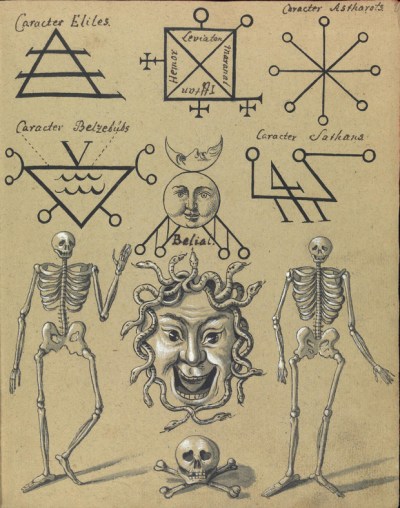Commonly referred to as The Compendium of Demonology and Magic, this is actually a corruption of the book’s original Latin title: Compendium Rarissimum Totius Artis Magicae Sistematisatae per Celeberrimos Artis Hujus Magistros, a close translation being, “A Rare Summary of the Entire Magical Art by the Most Famous Masters of this Art”. Written in both German and Latin, the book’s creation is shrouded in mystery, with the unknown author thereby deliberately adding to the supposed supernatural mythology.

Though the book’s title page – is inscribed with the year 1057, this is clearly fanciful by a good few hundred years, the anonymous writer clearly aiming to lead the reader to believe this book of watercolour paintings of demonic revelry and disgust had been passed from hand-to-hand across the centuries. Regardless of this tomfoolery, it still has significant age, with most scholars dating it to around 1775.

Bearing the ominous warning “NOLI ME TANGERE” (“Do Not Touch”), another clever touch to instil a feeling of ageless dread, the strangely-hued pages are also bordered with drawings of skeletons and mystic runes, sigils and symbols, all of which paves the way nicely for the 31 outlandish paintings, which are a combination of Greek and Roman mythology and Bosch-esque excess.
However, neither the text nor the imagery are in keeping with the time it was written – many years after witchcraft was supposedly rife around Europe; just before the Declaration of Independence in America; as well as being at the brink of the Industrial Revolution. One can only imagine it was something of a vanity piece or something the author created in order to make money when sold.
The book discussed some of the demonic ranking of Hell, listing kings, dukes and subjects, whilst the symbolic work refers to the elements and, at least to some extent, astrology. The original book is owned by the Wellcome Library in London, which has digitally scanned the book to make it readily available free of charge.

Such is the strangeness of the book and its alluring appeal, there have been physical reproductions made with wood, cow-hide and mull cloth, which have sold for unsurprisingly high prices.
Daz Lawrence, MOVIES & MANIA





Image credits: Wellcome Library
Related:
The Mythical Demons of Hell: Who’s Who in Satan’s Underworld
MOVIES & MANIA provides previews, our own film reviews and ratings, plus links to other online reviews from a wide variety of trusted sources in one handy web location. This is a genuinely independent website and we rely solely on the minor income generated by internet ads to pay for web costs and cover yet more movies. Please support us by not blocking ads. Thank you. As an Amazon Associate, we earn a very tiny amount from any qualifying purchases.